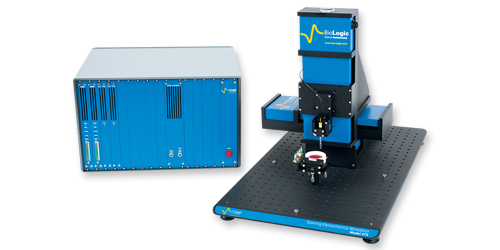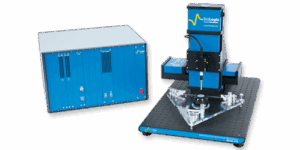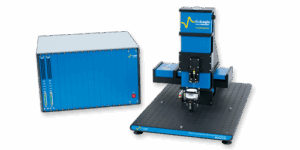Description
ic-SECM technique for M470
Intermittent Contact Scanning Electrochemical Microscopy
SECM with the ability to distinguish topographical and electrochemical induced response
The Intermittent Contact-Scanning Electrochemical Microscopy variant of BioLogic’s modular M470 scanning electrochemical workstation. It is a technique unique to BioLogic.
Intermittent Contact-Scanning Electrochemical Microscopy (ic-SECM) is a constant distance Scanning Electrochemical Microscopy (SECM) method. With ic-SECM users can measure distinct surface activity, and surface topography maps. With this single experiment, it is possible to correlate sample features and activity.
The ic-SECM technique is only available on BioLogic’s M470 scanning electrochemical workstation (under exclusive license from the Unwin group at the University of Warwick).
When ic-SECM is used, the probe to sample distance can be maintained over large areas, and even over very rough samples. It has been used to measure extremely flat samples to remove the effect of sample tilt, ensuring the strongest signal throughout the measurement. ic-SECM has found use in battery research, particularly to measure solid-state electrolytes. It can be used in corrosion research, particularly when the sample may be too rough to be investigated by constant height SECM techniques.
Overview: A powerful, versatile, easy to use system
- Measure surface activity and topography at the same time
- Push-button approach to automatically find sample surface
- Sample tilt is no longer a problem
- Available for both dc-SECM and ac-SECM
- Stronger signals
Single constant distance SECM measurement with activity and topography outputs
Constant height SECM is the most popular method of performing SECM, however, because both the sample activity and the probe to sample distance affect the SECM signal, it can be difficult to determine if the measured signal is a result of activity or topography. This can limit the sample types and sizes suitable for measurement by constant height SECM. When ic-SECM is used, however, the topography is tracked throughout the measurement, meaning there is no question that the signal measured is due to sample activity. Using ic-SECM samples which were once off-limits to SECM become possible. ic-SECM opens up the possibility of measuring much larger areas than with traditional measurements because sample tilt is followed, rather than causing detrimental decay to the signal. Furthermore, because topography is measured as a separate output, a correlation between the topography and activity is possible.
No approach curve required
In ic-SECM users can perform a push-button approach which automatically finds the sample surface. The push-button approach is based on the mechanical control mechanism used throughout ic-SECM. This means that the ic-SECM approach can be performed even in situations where a standard approach curve could be difficult for even experienced users, for example when the corrosion product of a surface is the redox mediator of interest.
Topography and tilt are no longer an issue
The usefulness of constant height SECM is limited if a sample has large topography changes, and/or large background tilt. In these cases, the difficulty in separating the effect of sample activity and topography are minor in comparison to the topography changes being too large to measure anything but a bulk signal in regions. This can really limit the sample types and sizes suitable for measuring by constant height SECM. When ic-SECM is used, however, samples that were once off-limits to SECM become possible. ic-SECM opens up the possibility of measuring much larger areas than with traditional measurements because sample tilt is followed, rather than causing detrimental decay to the signal. By letting the probe approach closer than would be possible in constant height measurement, ic-SECM has the added advantage that it also results in a stronger signal than would otherwise be possible.







